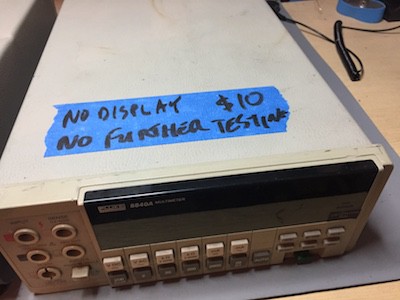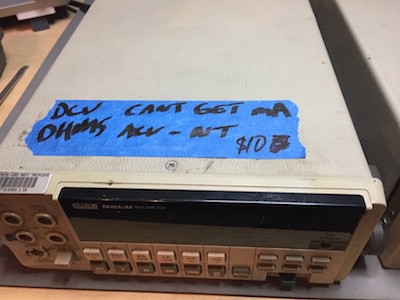-
fixing rather than building: rules for buying old test equipment
10/23/2019 at 18:41 • 0 commentsFor the last year or so, I've been acquiring older (80s and 90s, mostly) test gear. Lots of it comes from hamfests, most of it is is in poor physical condition from long storage, and little of it works when I plug it in. This means it is cheap. It also means that, if one can get it working, the price/performance is often quite amazing.
An example: I just picked up two Fluke 8800A DMMs. 5.5 digits, 4 wire resistance measurements, mV to KV range, etc. The new version of this meter sells for almost 900USD. I bought these two for fifteen bucks. Granted, they weren't in great shape:
But even if I combine two meters into one (and baseed on an hour's work of bench time, it looks like I can) I get a working precision DMM for a twentieth of the cost of a new model. That's a pretty good deal.
Other than the siglent SA on my bench, almost everything I use - signal generators, DMMs, oscilloscopes, power supplies - looked like these two meters when I bought them.
Here's some simple rules to follow:
- RTFM first. You should have, and have read, the service and user manuals. Be sure that what you are buying is repairable, can be adjusted/calibrated, and doesn't involve exotic or custom parts that are likely to be unobtainium.
- Do your internet homework. Join forums and email lists where people who use and fix old test gear are hanging out. Ask questions; most folks are happy to help the noob. Watch ebay to see what pricing for "working" gear looks like. Know what similar gear costs new.
- Don't judge a book by its cover. This is a mostly true rule. Lots of swapfest gear will be covered with stickers, incredibly dirty, and otherwise dinged up. That's what makes it a bargain and that stuff is easy to remedy. When is it not true? Avoid gear that looks like it has gotten wet, been run over, or has a lot of broken or missing knobs.
- Carry a test kit and tools. With a simple voltage and resistance reference, cheap signal generator, and some test probes, along with a couple of screwdrivers and hex keys in hand, you can test things on the fly and, often, open it up to see if all the boards and ICs are in the box. For bonus points, carry a power cord.
- Sometimes you get the bear, sometimes the bear gets you. Once in a while, you will overpay or the stuff you buy will turn out to be not fixable or not worth fixing. Don't let that stop you.
Though these rules are my primary guide to buying, sometimes I take the lottery ticket approach: this is really cheap and if I can get it to work it will be a huge win! Sometimes it doesn't work out... I bought two HP function generators that are essentially bricks; although I know how to fix them, I will never find the custom ICs that need to be replaced. The same day, I bought a B+K curve tracer that was up an running after an hour on the repair bench.
Even if you can afford to buy the latest and greatest test equipment, mucking with older gear is a great way to learn how TE works. Gear from the 80s and 90s typically comes with extensive documentation including the theory of operation, use cases, schematics, and calibration instructions. You won't get much of that when you buy a Siglent scope!
Last thing. You can find a lot of good stuff on test equipment over on the eevblog TE forum. I post tear downs and repairs (these two Fluke meters will be there), as do a lot of other folks.
-
NOS components: hunting unobtanium and reliving the 80s
12/16/2018 at 03:30 • 0 commentsI've been focusing on building RF gear for the last year or so, mostly stuff comprised of individual transistors and the occasional op amp. This is its own kind of rabbit hole because many of the components from these 80s era designs haven't been manufactured for fifteen to twenty years.
I have an active "hunting" list of forty or fifty parts, mostly BJTs, FETs, and small scale ICs that are used over and over again in the designs I am trying to replicate. Because I was a bench engineer in the 80s, I know they were once cheap and plentiful. Today, assuming you can find them at all, the going prices are often astonishing.
The old HP2800 pin diode, which probably cost less than a dime when it was being produced, is now hard to find for less than ten bucks. When you need four of them for a mixer, well, that gets to be a pretty expensive project pretty quick. And the dual gate MOSFETs that Doug Demaw used everywhere in his QRP rig designs? At the going rate of five to thirty-five bucks a pop, a receiver with six or eight of them is costs way more than an RTL-SDR dongle.
That said, I like building with unobtainium. Tracking down rare parts and, better yet, finding a stash of them that I can afford, is as much a part of building as waving a soldering iron around. Maybe I am weird, but when I manage to score a dozen Johnson air variable caps for two bucks a piece or someone offers me a handful of RF transistors that I've been hunting for a year, I am having a pretty good day.
Is looking for this stuff as much fun as building? Nope... but some days it is pretty close. -
working computers: macbooks w osx/win10
11/25/2016 at 20:21 • 0 commentsi use a macbook pro (2009 vintage) and a macbook air (2013). both have after market SSDs (MBP 500GB, MBA 1TB) and as much RAM as could be stuffed into them. Both machines dual boot OSX and Win10. The MBA has parallels desktop also installed.
I use the MBP for ARO, so I run Win10 an awful lot. The MBA is my general purpose and troubleshooting machine. The MBP is getting harder to find, which isn't surprising because it is user-repairable and ungradable, a feature that is rapidly disappearing from apple hardware.
My Pages
Projects I Like & Follow
Share this profile
ShareBits
Become a Hackaday.io Member
Create an account to leave a comment. Already have an account? Log In.
 worsthorse
worsthorse

 Michael R Colton
Michael R Colton Just4Fun
Just4Fun f4hdk
f4hdk Lutetium
Lutetium Tim
Tim Daemon informatica
Daemon informatica W5VO
W5VO Rjpope42
Rjpope42 Richard Deininger
Richard Deininger Thomas
Thomas philenotfound
philenotfound taposk
taposk Alex Hiam
Alex Hiam